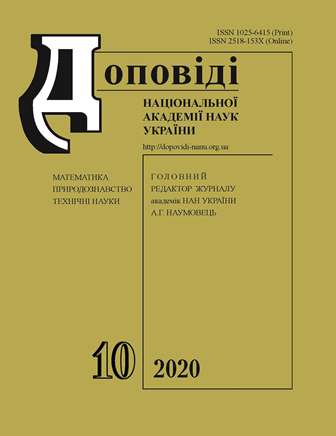Реалізація ефекту порятунку на цитогенетичному рівні внаслідок взаємодії між інтактними нормальними та опроміненими малігнізованими лімфоцитами крові людини
DOI:
https://doi.org/10.15407/dopovidi2020.10.077Ключові слова:
іонізуюча радіація, аберації хромосом, ефект порятунку, змішана культура лімфоцитів крові людини, хронічна лімфоцитарна лейкеміяАнотація
Досліджено вплив інтактних лімфоцитів крові умовно здорових осіб на стабільність геному лімфоцитів крові хворих з первинним діагнозом В-клітинна хронічна лімфоцитарна лейкемія (ХЛЛ), опромінених in vitro на G0 стадії клітинного циклу γ-квантами 137Cs у дозі 0,50 Гр. Для дослідження використано власну модельну систему кокультивування лімфоцитів крові різностатевих осіб, розроблену для вивчення різних проявів феномену bystander response на цитогенетичному рівні. Встановлено зниження радіаційно-індукованої частоти аберацій хромосом в опромінених клітинах хворих на ХЛЛ з 12,88 до 9,56 на 100 метафаз (p < 0,01) внаслідок зменшення рівня аберацій хроматидного типу (з 5,66 до 2,83 на 100 метафаз, p < 0,001), які вва жаються маркерами хромосомної нестабільності. Частота нестабільних цитогенетичних маркерів радіаційної дії (ди центричних і кільцевих хромосом) залишилася незмінною (р > 0,05). Отримані дані свідчать про те, що результатом взаємодії опромінених in vitro клітин крові хворих на В-клітинну ХЛЛ (клітин-мішеней) з інтактними лімфоцитами крові умовно здорових осіб (клітинами-свідками) є зниження рівня хромосомної нестабільності в клітинах-мішенях, що подібно до реалізації ефекту порятунку першого типу.
Завантаження
Посилання
Chen, S., Zhao, Y., Han, W., Chiu, S. K., Zhu, L., Wu, L. & Yu, K. N. (2011). Rescue effects in radiobiology: unirradiated bystander cells assist irradiated cells through inter-cellular signal feedback. Mutat. Res., 706, pp. 59-64. https://doi.org/10.1016/j.mrfmmm.2010.10.011
Lam, R. K. K., Fung, Y. K., Han, W. & Yu, K. N. (2015). Rescue effects: irradiated cells helped by unirradiated bystander cells. Int. J. Mol. Sci., 16, pp. 2591-2609. https://doi.org/10.3390/ijms16022591
Fu, J., Yuan, D., Xiao, L., Tu, W., Dong, C., Liu, W. & Shao, C. (2016). The crosstalk between α-irradiated Beas-2B cells and its bystander U937 cells through MAPK and NF-κB signaling pathways. Mutat. Res., 783, pp. 1-8. https://doi.org/10.1016/j.mrfmmm.2015.11.001
Yu, K. N. (2019). Radiation-induced rescue effect. Radiat. Res., 60, Iss. 2, pp. 163-170. https://doi.org/10.1093/jrr/rry109
Shemetun, O. V., Talan, O. O. & Pilinska, M. A. (2006). Model for the study of radiation-induced bystander effect using human peripheral blood lymphocytes. Journal of the Academy of Medical Sciences of Uk raine, 12, No. 3, pp. 556-565 (in Ukrainian).
Pilinska, M., Dybskii, S., Shemetun, O. & Dybska, O. (2011). Cytogenetic effects. In Helth effects of the Chornobyl Accident — a Quarter of Century Aftermath (pp. 235-250). Kyiv: DIA.
Mukherjee, S. & Chakraborty, A. (2019). Radiation-induced bystander phenomenon: insight and implications in radiotherapy. Int. J. Radiat. Biol., 95, Iss. 3, pp. 243-263. https://doi.org/10.1080/09553002.2019.1547440
Pilinska, M. A., Shemetun, O. V., Talan, O. A., Dibska, O. B., Kravchenko, S. M. & Sholoiko, V. V. (2020). Cytogenetic effects in mixed culture of blood cells from patients with chronic lymphocytic leukemia with blood lymphocytes of healthy individuals. Dopov. Nac. akad. nauk Ukr., No. 7, pp. 86-93 (in Ukrainian). https://doi.org/10.15407/dopovidi2020.07.086
Kurinnyi, D. A., Rushkovsky, S. R., Demchenko, O. M., Sholoiko, V. V. & Pilinska, M. A. (2020). Evaluation of the interaction between malignant and normal human peripheral blood lymphocytes under cocultivation and separate cultivation. Cytol. Genet., 54, No. 2, pp. 124-129. https://doi.org/10.3103/S0095452720020103
Shemetun, O. V., Talan, O. A. & Pilinska, M. A. (2014). Cytogenetic features of induction and persistence of radiation-induced bystander effect in human lymphocytes. Cytol. Genet., 48, No. 4, pp. 51-58 (in Russian).
Atramentova, L. A. (2014). Design and statistics (biological research). Kharkiv: NTMT (in Russian).
Djomina, E. A. (2019). The dependence of dose/effects in human radiation сytogenetics. Problems of Ra diation Medicine and Radiobiology, Iss. 24, pp. 235-249. https://doi.org/10.33145/2304-8336-2019-24-235-249
Döhner, H., Stilgenbauer, S., Benner, A., Leupolt, E., Kröber, A., Bullinger, L., Döhner, K., Bentz, M. & Lichter, P. (2000). Genomic aberrations and survival in chronic lymphocytic leukemia. N. Engl. J. Med., 343, No. 26, pp. 1910-1916. https://doi.org/10.1056/NEJM200012283432602
Durak, B., Akay, O.M., Aslan, V., Ozdemir, M., Sahin, F., Artan, S. & Gülbas, Z. (2009). Prognostic impact of chromosome alterations detected by FISH in Turkish patients with B-cell chronic lymphocytic leukemia. Cancer Genet. Cytogenet., 188, No. 2, pp. 65-69. https://doi.org/10.1016/j.cancergencyto.2008.08.019
Lai, Y. Y. & Huang, X. J. (2011). Cytogenetic characteristics of B cell chronic lymphocytic leukemia in 275 Chinese patients by fluorescence in situ hybridization: a multicenter study. Chin Med. J., 124, No. 16, pp. 2417-2422.
##submission.downloads##
Опубліковано
Як цитувати
Номер
Розділ
Ліцензія
Авторське право (c) 2023 Доповіді Національної академії наук України

Ця робота ліцензується відповідно до Creative Commons Attribution-NonCommercial 4.0 International License.




